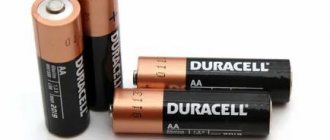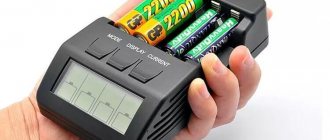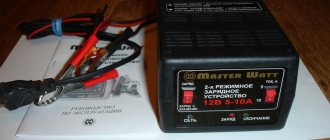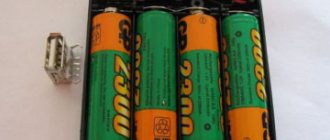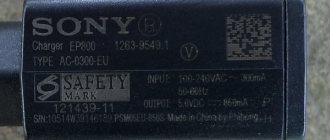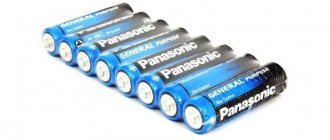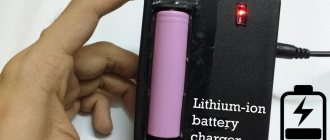Using ordinary batteries is unprofitable, since their service life is very limited. Therefore, it is more practical to use batteries. Their advantage lies in repeated use, provided they are handled correctly. First of all, this is due to the conditions for their recharging. Batteries, releasing accumulated energy to devices, periodically need to be charged. This is what battery chargers are for.
Alkaline battery design
The size of the cylindrical element is similar to the size of the element of the manganese-zinc system with a salt electrolyte.
However, there are some differences between the design of alkaline and salt power sources: alkaline batteries have an inverted design. In a battery containing an alkaline electrolyte, zinc is in powder form. In this regard, the zinc cup is replaced with a nickel-plated steel cylindrical body, which serves as a current conductor for the electrode with the “+” sign. In the active state, the positive electrode is pressed against the inner walls of the housing. In an alkaline cell, as a rule, it is possible to place a larger amount of the active mass of the positive electrode than in a salt analogue of the same size. Thus, an alkaline D-type battery can contain 35–40 g of manganese dioxide. A salt battery of this size holds no more than 25–30 g of electrolyte.
The separator is pre-impregnated with electrolyte and then inserted into the internal cavity filled with the active mass of the anode. The separation material can be hydrated cellulose film or some non-woven polymer material.
Read also: How to make a generator from a screwdriver
A current lead (made of brass) of the cathode is placed along the axis of the chemical current source, and an anode composition consisting of zinc powder is introduced into the cavity between the brass current lead and the separation material
It is important that before this the zinc powder is saturated with a thickened electrolyte
In production, alkalis pre-saturated with zincates are often used as electrolytes. This measure reduces alkali consumption at the initial stage of operation. In addition, the zincates present in the electrolyte inhibit the development of the corrosion process.
Box for aa batteries
The compartment is for carrying. This way the batteries will be most protected from moisture and short circuits. Most often, containers for type AA elements are made of plastic. But sometimes you can find homemade paper boxes.
A regular snap bag can also serve as a case. This packaging is impervious to moisture and dust. Housings are made for different numbers of energy sources. On sale there are cases with a lid for 6-8 AA batteries. Such cassettes last for a long time. So they are quite durable.
In principle, if you show a little ingenuity, you can make an aa block with your own hands. You just need to find a suitable box and make a rectangular container from it. Such a device will help out if there is a need for carrying.
Main characteristics of batteries
We've sorted out the terminology, now let's see what types of batteries there are and how they differ from each other.
Form factor
Modern batteries - both galvanic cells and batteries based on them - are available in various form factors. The most common are cylindrical and disk. Some batteries may be rectangular in shape.
The most popular sizes of galvanic cells and batteries
As for batteries, they can exactly repeat the shape and size of galvanic cells, but they can also have an original shape. In the photo below, from left to right, you can see a cylindrical AA battery of 3.7 volts (but not 1.5, like a regular AA battery), a disk one that exactly follows the shape of a lithium galvanic cell, and a disk one of the original shape (tablet).
Batteries, like galvanic cells, can be produced in different form factors
Battery types
Based on the type of electrolyte and electrode material, galvanic cells can be divided into:
Saline. Elements of this type have electrodes based on manganese and zinc; salt, ammonium chloride, is used as an electrolyte. The devices are characterized by low electrical capacity and fragility, but have a low cost.
Alkaline. In cells of this type, the same materials are used for electrodes, but alkali is used as an electrolyte - potassium hydroxide. Batteries of this type have higher capacity and longer service life. They are capable of developing high supply currents, but are several times more expensive than salt cells. Alkaline batteries are often called alkaline or alkaline.
Lithium. The anode of these elements is made of lithium, while the cathode and electrolyte are selected depending on the required output voltage, which can vary from 1.5 to 3.0 V depending on the purpose of the current source. Lithium galvanic cells (not to be confused with lithium batteries) have a high capacity, are durable (work for years), but are more expensive than alkaline ones.
Lithium AA battery (voltaic cell)
Silver-zinc. These batteries usually come in tablet form. They can be found in wristwatches and similar small-sized, economical equipment. This is a compact and durable current source, but it is quite expensive (relative to the capacity) and does not have a large electrical capacity.
Output voltage
The output voltage of all salt and alkaline galvanic cells is 1.5 V. Silver-zinc “tablets” produce the same 1.5 V. Lithium cells, as mentioned above, depending on the type of cathode and electrolyte, can have an output voltage from 1.5 to 3.0 V.
Nickel-cadmium (Ni-Cd) and nickel-metal hydride (Ni-MH) rechargeable batteries (accumulators) produce 1.2 V. This type of battery is the most popular and is often used as a replacement for finger (AA format) and little finger (AAA) galvanic cells.
Nickel-cadmium (left) and nickel-metal hydride batteries in AA and AAA formats
Nickel-zinc (Ni-Zn) batteries have an output of 1.6 V.
Recently, lithium-ion and lithium iron phosphate batteries have become widespread. The former produce 3.7 V, the latter - 3.2 V. They may have the same form factor as salt or alkaline batteries, but due to the difference in output voltages, one cannot be replaced with another.
Types of batteries
Only batteries can be recharged multiple times. It is easy to recognize them from a wide range of stores: the capacity is indicated on them in large four-digit numbers.
Based on their composition and method of discharging an energy charge, batteries are divided into:
- nickel-cadmium;
- nickel metal hydride;
- nickel-zinc;
- lithium-ion;
- lithium polymer.
The first type in the list has a memory effect, which means that during operation they need to be completely discharged and only then plugged into the network via a charger.
The following sizes are available among battery power sources:
- little finger;
- finger;
- keg (D battery);
- crown (corundum);
- ½ AA.
Button-type batteries can only be found in specialized hearing aid stores.
The charge capacity is indicated on the battery in large numbers. This figure ranges from 150 to 6500 mAh.
The larger it is, the longer the battery cell will last. At the same time, the cost of a battery with high performance is an order of magnitude higher.
But is it different for lithium-ion batteries in phones and laptops?
The same applies to lithium-ion batteries. Of course, no one has canceled the concept of “charging and discharging simultaneously with the release of heat” (if you understand what we’re talking about), but in practice the EMF of a regular gadget is about 3.7 V, and the charging voltage is much higher (~5 V). That is, the battery is not used while charging.
About the concept of “charging and discharging simultaneously with heat release”
Here's what sometimes happens in laptops: If a battery-powered external power supply device can handle heavy loads, the battery ends up being used as a buffer for external power.
For example, a circuit requires a circuit of 10 A for 30 seconds, then 1 A for the next 30 seconds. Yes, voltage matters, but let's just stick to current to explain things more simply.
So overall we need 5.5A on average. Let's assume that the external power supply can provide 6 A (laptops usually have 4.74 A and 6.3 A adapters, but let's simplify for the sake of this example).
Thus, for 30 seconds of every minute the battery is discharged at a rate of 4.4 A. During the remaining 30 seconds, it can be charged at 4.6 A. In this case, 0.2 A is the charging and discharging loss. In other words, at the end of the cycle the battery is at the same level as before. This 0.2A is what generates the heat.
Number of cycles
It is worth remembering that each time you recharge a battery, its service life deteriorates. Thus, for nickel-cadmium batteries no more than 1000-1500 discharge/charge cycles are allowed.
For modern batteries, they are trying to increase this figure, bringing it to 4000 cycles.
And if a brand new rechargeable battery has completed the full “training” course 3-4 times, then it is considered that it has reached performance characteristics that will be maintained throughout its entire service life.
You can learn about how to properly use rechargeable batteries, precautions and other tricks:
- in technical documentation;
- in the operating instructions;
- in the articles on our site.
The lifespan of an average rechargeable battery is 3 years.
AA batteries are the most common and sold along with pinky batteries. They are a type of finger-type battery and have been produced since 1907. Galvanic batteries have characteristics that are optimally suited for many modern devices. This leads to a wide scope of application, a large selection among domestic and foreign manufacturers.
Contents
Power supplies marked AA have different characteristics depending on the type of electrode installed. But they also have identical characteristics. First of all, these are the sizes.
Battery AA li-ion
AA AA batteries are a cylinder with a diameter of 13.5 to 14.5 millimeters. The length together with the contact protrusion (it occupies about a quarter of the main diameter) is 50.5 millimeters. The cylindrical part is completely covered with an insulated shell to avoid possible short circuits or corrosion.
The terminals are located on different sides of the battery. On the positive terminal there is a protrusion, the height of which is about 1 millimeter. A negative terminal is a flat or slightly raised surface.
The weight of power supplies varies. Salt ones weigh approximately 14-18 grams, alkaline ones - from 22 to 24 grams, and nickel ones - 30 grams. The latter option is equipped with a voltage converter, therefore such batteries can be charged, that is, they perform the functions of batteries and in fact are them.
How to recharge: two experiments
It is impossible to charge the batteries - scientists struggled to clean oxides from the contacts without disassembling the battery. There is no way to reverse the reaction. But to carry out this experiment, you need special equipment, and you shouldn’t do it at home.
What if you put a battery in a battery charger? Miss Clean magazine strongly recommends against doing this: there is a high risk of an explosion.
Why does it explode
Basically, the problem is alkali. If you pass a reverse current through it, it will begin to heat up, releasing gas. And BOOM! The alkali and its reaction products will scatter throughout the room, and fragments of the body will easily burn and injure your hands and face.
But they showed it on YouTube!
Indeed, there are videos on YouTube in which batteries are charged. In essence, this is a way to slightly extend the battery life, nothing more.
How it's done:
- The battery is placed in the charger for approximately 15 minutes.
- Strictly monitor the temperature. As soon as the battery has warmed up to 40 degrees (you can feel it with your palm so that the cool case has become warm) - get out of the device.
This “reanimation” is enough for the battery to last another 5-10 minutes. It is much easier and safer to go to the store and buy new batteries.
The method is effective with cheap elements, but not with expensive ones. Why? Because the latter use higher quality materials, and the electrons are not blocked by oxides, but are consumed to the end, and it will not be possible to rip them back out of the anode. If it were possible, the cell would be called a battery.
Let's summarize. There is no point in charging batteries, especially expensive ones - it’s easier to buy new ones. And safer. If you are concerned about the environment and savings, spend a certain amount one-time and purchase two sets of batteries and a charger. This set will serve you for many years, so you will forget to think about batteries and buying them, especially charging.
AA battery holder
This device is designed to secure AA types. Usually it is a plastic container. On the one hand, it is covered, and on the other, it is open. Inside there are contacts, some of which are made of metal plates. And the other part is made in the form of springs.
Black and red wires come out of this plastic box from the outside. You can make a similar holder for aa types yourself. To do this you will need:
- Scissors.
- Scotch.
- Plastic bottle.
- Empty cigarette packs.
- Wires for outputting electricity.
Thus, almost anyone can make this device.
Additional charger options.
In addition to recharging batteries, energy replenishing devices can perform the following functions:
- Battery discharge function. In addition to being able to charge, these devices can drain the battery. This function is needed if the charged batteries are not planned to be used for a long period of time.
- Battery recharge function. This function is useful when the batteries in use need to be slightly recharged, and the charge level does not necessarily have to be at a low level. In essence, recharging adds another layer of charge to the existing level of charge, but this method can bring the battery to the end of its useful life much faster. The most interesting thing is that in the case of recharge, the battery life also decreases. If, with a full charge, the battery can work for about a day, then in the case of recharging, the work will only last for a few hours.
- Battery precharging function. Thanks to this feature, it is possible to restore the working condition of completely discharged batteries without causing undesirable consequences.
- Trickle charging function. In this case, electricity enters the battery in a uniform layer and does not affect the shutdown when the charge level is full.
- Fast charging function. This function is characterized by a fast supply of electricity, smoothly transferring to the spare compartment.
How to extend the life of batteries
Despite the attempts of some craftsmen to recharge batteries, their device does not allow reversing chemical processes, as happens with batteries
If it is not possible to replace the battery with a new one, then there are several methods, to varying degrees unsafe, to extend the operating time:
- Short-term increase in temperature. For example, dip the battery in hot water for half a minute. Do not heat it over an open fire.
- Hull deformation. By squeezing the outer capsule of the battery, you can achieve a short-term increase in charge. Danger arises when the integrity of the housing is damaged and a caustic solution leaks. This operation cannot be performed with teeth.
Disposable alkaline batteries are difficult to “reanimate”; recharging them is accompanied by the risk of burns from leaked electrolyte. Therefore, it is easier to buy new batteries.
A battery is that element of everyday life without which a person today will have a hard time. Without batteries, most electronic devices cannot function, be it a simple watch, a flashlight, or an abstruse children's toy. Batteries are divided into two types: rechargeable (rechargeable) and galvanic (disposable). For many, a question like “Is it possible to charge a disposable battery” remains open, so next we will try to look at the most common ways to charge batteries.
Dummy AA battery
This thing serves as a substitute for a real power source. It can also be used as a toy for children. Real batteries are dangerous to give to children due to possible toxic elements. And these are almost harmless. The only thing a child can do with them is swallow. Therefore, older children can play with them.
A do-it-yourself dummy AA battery is made from ordinary cardboard or 5 milliliter syringes. The picture below shows how such plastic things replace real energy sources in the camera.
A wire protrudes from this device, to which you can connect any 3-volt power source. In some cases this approach is convenient.
Here's what you'll need:
- 2 syringes 5 ml or cardboard/paper.
- Metal round plates from old batteries.
- Wires.
- A capacitor can be used as an energy storage device.
Next, a dummy is made from all this as shown in the picture above. The main thing is not to confuse the polarity.
Microprocessor charger: charging with brains
Devices with a microprocessor are more expensive, which is why they are most often used by those who need batteries for their occupation. For example, photographers. But the prices are by no means astronomical, so nothing prevents you from making a choice in favor of a smart charger. How is it usually better?
- Has settings. You can independently set the optimal current for a specific battery.
- Has independent channels. You can charge only one battery, or you can have a battery with a capacity of 1600 mAh in one slot, and a battery with a capacity of 1600 mAh in the other, and both will be charged 100%.
- Has foolproof and overheating protection. They simply won't turn on until you place the batteries in the correct way and will turn off if the battery gets too hot.
- Has special modes. For example, “Training” - successive cycles of charging and discharging the battery in order to restore its capacity.
- Has a display. You see all the information about the accumulated capacity, voltage, current...
Method 4: Volume reduction
The method is quite incomprehensible and exotic at first glance. We need to reduce the size of the battery so that the charge in it is restored on its own.
What should you do for this? Mechanically reduce and make the body volume thinner. To do this, the battery is hit against something hard - asphalt, wall, stone, brick, etc. Or they simply trample on it with thick shoes. You can try to flatten it with a handy tool - for example, pliers.
This method will charge all AA batteries. It must be said that such a “barbaric” method helps restore the charge in some cases even to 100%!
Method 2: Power Supply
Let's look at how to charge batteries at home. For this method, you will need a power supply and wires to connect to it. Everything is in place? Here are the instructions for action:
- First of all, connect the battery to the power supply with wires. It is important to maintain polarity here - connect plus with plus, minus with minus. This is easy - “+” and “-” are marked on the body of the used battery.
- After you have connected the battery, wait until it reaches 50°C. Then unplug it from the power supply.
- Be sure to wait a few minutes to allow the element to cool down. Otherwise, you can provoke its explosion!
- While the battery is still warm, reconnect it to the power supply for about 2 minutes.
- But now the element needs to be placed in the freezer for 10 minutes.
- After this time, remove the battery and wait a few minutes until it warms up to room temperature.
- That's it, the charge is restored! The element can be used for its intended purpose.
When receiving a rechargeable AA battery using this method, pay attention to these recommendations:
- The process will not work if you reverse the polarity when connecting the wires. Moreover, in this way you will destroy the remaining charge in the element.
- Using the described method, the battery can be charged 1-2 times.
- The method is only suitable for finger-type alkaline cells!
- The procedure can be performed in any environmental conditions (with the exception of the freezer stage).
Effective online calculator
The question that worries me is how many hours it takes to charge the batteries, there is a logical and simple answer. Thanks to a simple formula for calculating the result, you can obtain the necessary data in a few seconds. To do this, you need to enter the parameters of the battery capacity and charger current into the table. Click the “calculate” button and accept the ready answer.
Attention: the resulting value must be multiplied by a factor greater than 1, because part of the energy turns into heat and is lost, especially at temperatures below zero. When calculating the charging time of nickel batteries, a percentage ratio of 1.4 is suitable
The battery discharge voltage should not be less than 0.9V, regardless of the discharge current. In most devices, the threshold value is determined automatically.
You can interrupt the charge, but the total value should not be less than the calculated value. During the charging process, the device body may heat up, the maximum temperature is 55 degrees. In this case, the device switches from the main charging mode to the secondary charging mode. The temperature drops and the process is renewed.
Can batteries be charged?
For the sole purpose of “stirring up” hidden resources, you can place the battery in a charger and connect it to the mains for no more than 15 minutes, regularly monitoring its external temperature.
The following happens inside the battery:
- High currents flow through internal reactants.
- The dielectric obstacle (crust) is destroyed.
- Free elements begin to react.
- The battery regains some of its charge, but does NOT charge.
Actually, for the same purpose, an ordinary battery is bitten with teeth, tapped, and artificially resuscitated.
In this case, the battery does NOT charge, but only increases its efficiency.
ATTENTION! If you forget to remove the battery in time or it overheats, serious troubles are possible:
- battery breakdown;
- swelling;
- bloating;
- release of gases;
- electrolyte boiling;
- leakage of electrolyte, alkali;
- a battery explosion with all the ensuing consequences - damage to the charger, alkali particles flying around the apartment, etc.!
Method 3: Heating
You can also restore the battery charge by regular heating. But be careful - this method can cause the product to explode!
The simplest thing is this:
- Fill a container with hot (but not boiling) water. Put batteries there.
- How long does it take to charge batteries this way? Keep them in water for no more than 20 seconds so as not to provoke sad consequences!
- Wait until the battery is completely dry and cools down to room temperature. That's it, you can use it!
In the Union, the batteries were being charged...
Many craftsmen in Soviet times charged dead batteries. That's what they thought. In fact, the battery design does not allow chemical processes to be reversed, as happens with batteries.
Older galvanic cells used salts that could clump or create a crust of residue on the current collectors. Passing current through the battery eliminated these awkward moments and forced more reagents to react. Unfortunately, in most cases, about 30% of the substance remained unused. Thus, what the craftsmen called recharging the battery was in fact just a small shake-up.
Modern galvanic cells leave no more than 10% of the substance unused. The more expensive the reagents, the greater their capacity, while the same ones on silver work 7-10 times longer, but they are also not cheap at all. In normal everyday conditions, simple salt batteries are sufficient. They aren't so expensive that you risk your health trying to figure out a way to charge them.
Choosing a charger
And finally, let’s look at which chargers are chosen by users of devices powered by rechargeable batteries. The table was compiled according to the degree of popularity of the latter.
Rating of chargers by popularity
| Rating | Appearance | Model | Manufacturer | Battery type | Battery size | Number of compartments (independent channels) | Additional functions | price, rub. | Where can I buy |
| 1 | Nitecore D4 | TM Nitecore | IMR/Li-ion, Ni-MH/Ni-Cd | AA (R6), AAA (R03), AAAA, C (R14), 26650, 22650, 18650, 10440, 14500, 16340, CR123A, 17670, 17500, 18490, 18350 | 4 | Automatic type detection, status display on LCD display, capacity detection, restoration, protection against polarity reversal, overcharge, overdischarge, powered by car cigarette lighter | 2 200 | Ya.Market | |
| 2 | Liitokala Lii-500 | Liitokala | Li-ion, Ni-MH | 18650, 18490, 18350, 17670, 17500, 17335, 16340 (RCR123), 14500, 10440, 26650, 22650, 26500, A, AA, AAA, SC | 4 | Automatic type detection, LCD status display, test function, recovery, reverse polarity protection, overcharge, overdischarge protection, USB port 5V/1A | 2 700 | Ya.Market | |
| 3 | Palo P10 | Palo | NI-MH, NI-CD | AA, AAA | 8 | LED charge indication, fixed charging current (200 or 180 mA), low cost, pair charging, pair auto-off at the end of charging | 900 | ||
| 4 | Opus BT-C3100 v2.2 | Opus | Ni-Cd, Ni-MH and Li-Ion | AA, AAA, C (R14), 10440, 16340, 14500, 17500, 17335, 17500, 18490, 17670, 18650, 22650, 26650 | 4 | Auto-detection, charge/discharge/testing, status display on LCD display, charging and recharging current programming, trickle charging mode, recovery | 2 800 | Ya.Market | |
| 5 | SkyRC MC3000 | SkyRC | NiMh, NiCd, NiZn, Eneloop, Lithuim-Ion, Lilo4.35, LiFeP04 | AA, AAA, C, D, SC, AAAA, 18650, 14500, 16340, 32650, 14650, 17670, 10440, 18700, 18350, RCR123, 18500, 18490, 25500, 13500, 13450, 1665 0, 22650, 17500, 10340, 17650, 10500, 26500, 12340, 12500, 12650, 14350, 14430, 16500, 17350, 20700, 21700, 22500, 32600 | 4 | Automatic type detection, status display on LCD display, remote control via Bluetooth 4.0, recovery, protection against polarity reversal, overcharge, overdischarge, temperature control, USB port 5 V/2.1A, power supply from on-board network, maximum charging current up to 3 A | 7 000 | Ya.Market |
How to understand how long to keep charging the battery
It may well happen that after putting the battery on charge and waiting for some time, you discover that no charging has occurred. There is no need to suffer any further. Clearly something went wrong. Maybe the battery itself is faulty, or maybe the charger is faulty.
The most important thing when dealing with batteries is to charge them correctly. And for this you need to know exactly and observe their charging time.
To determine this time, you can go in two ways:
- Go to one of the specialized sites and calculate everything in an online calculator. Everything here is simple and clear.
- You can calculate this time yourself. A formula has been developed for this.
Formula for calculating charging time and its fineness
To calculate the time required to fully charge the battery, use the formula:
Time required for charging = battery capacity / current * recharge coefficient, which ensures a 100% charge.
The coefficient can be from 1.2 to 1.4
For this formula to work, the following factors must be taken into account:
- In order to charge the battery, you need to spend from four to twenty hours. No more, but no less. If the battery is charged earlier than four hours, the charger itself will stop supplying current. The battery can now be used. If the battery has not been charged in more than twenty hours, then the current strength is very low. In this state, the battery can remain in the charger for almost a week. It won't do him any harm.
- The capacity value can be taken from the battery case, or you can find it out from the information on the packaging or in the instructions.
- The current required for charging is written on the battery case, and it is also duplicated in the instructions.
The time it takes to recharge is not constant. This depends on several factors:
- chemicals included in the battery;
- ambient temperature;
- amount of charge remaining in the battery.
Number of recharge cycles
When using rechargeable batteries, be aware that they do not last forever. Their resource is gradually decreasing, and each new charge brings this closer. For example, batteries based on nickel and cadmium can be recharged between a thousand and one and a half thousand times. True, newer batteries can be recharged up to four thousand times.
The main thing for a battery is the first four recharge cycles. At this time, the battery capacity “builds up”, which will remain throughout the entire operation of the product.
Do not be lazy to study the instructions for the battery in detail. They are written by smart people and describe in detail how to charge the device.
How long do you have to wait for the battery to charge?
Calculating the amount of time required to fully recharge a battery is easy. To do this, divide the battery capacity by the charger current. Do not forget to take into account the coefficients. They range from 1.2 to 1.6.
To find out which coefficient needs to be applied, let's look at the difference between the current and the battery capacity value. The greater the interval between them, the greater the coefficient value we use.
Online calculators on special websites operate on exactly the same principles.
What batteries can be recharged?
In order for the battery to be recharged, it must be of a special, rechargeable type. You can determine which battery we have in front of us by reading the information indicated on the case. Do not even try to insert simple, disposable batteries into the charger.
If you do not follow this recommendation, the following may occur:
- if you are a lucky person, then nothing will happen;
- the battery may boil;
- the housing will overheat and, as a result, fire or explosion.
- It may also close the network.
It is precisely because of these likely consequences that you should not insert ordinary batteries into the charger.
In their shape, batteries are very similar to simple batteries. Among the batteries there are the same types, except for the tablet form. Limited quantities of tablets are produced. Those button batteries that are produced are intended for hearing aids.
The user may have a natural question: “How should batteries be charged?” The question is correct, because in order for the battery to be used for a long time, the charging process must be approached competently. You cannot take the battery and leave it on charge for two or three days. There is a simple formula to determine the exact recharging time, or you can use various services that have calculators for calculating time.
Why do regular batteries not charge?
The appearance of rechargeable batteries and simple batteries is almost the same. This leads many to mistakenly assume that all batteries, without exception, can be recharged. Naturally, this is far from the truth. All processes that occur in conventional batteries cannot be reversed. But in battery-powered ones it’s easy.
The process taking place inside both types of batteries is based on a single principle. The energy of the chemical process is converted into electricity. Batteries contain a special substance called electrolyte. The electrolyte contains electrodes. As a result of the chemical reaction occurring at the electrodes, a potential difference occurs. As soon as the ends of the terminals are closed by a conductor, the electrical discharge passes to it. Gradually, the number of ions decreases, and the battery charge runs out.
What's the point of passing current through a simple battery? There is nothing and nowhere to be restored there.
A completely different picture with the battery. In them, both the electrolyte and the electrodes easily return to their original state. In rechargeable batteries, the electrodes and the electrolyte itself can be restored to their original state.
Design and principle of operation
Alkaline battery design.
The negative electrode of an alkaline battery is located in the center of the battery. It is a paste containing zinc powder, electrolyte and thickener. To protect internal elements from corrosion, the housing contains high-frequency zinc with the addition of third-party metals. This also allows manufacturers to exclude environmentally hazardous substances, such as mercury, from the composition.
The current conductor of the battery is provided by a brass rod passing through the powder. Thanks to it, the area of connection between the electrolyte and the electrode increases, which helps to reduce internal resistance and increase the discharge current.
The positive and negative electrodes are separated from each other by a porous structure, which is impregnated with the working solution. It also does not allow mixing pastes with different charges. The positive electrode consists of manganese oxide and graphite. It is this that fills the free internal space that remains between the membrane and the body.
Can an alkaline battery be charged?
The market for galvanic cells is diverse. Millions of different batteries roll off assembly lines every day. There are plenty of cheap copies available to everyone. They can be purchased at the checkout counter of any supermarket or electrical goods store. Thus, the question of whether alkaline batteries can be charged has lost its relevance. Everyone knows from a school chemistry course that when the caustic alkali contained in batteries is heated, a violent chemical reaction can occur. The reverse current of the charger, passing through a closed space, provokes boiling of the battery and even a thermal explosion.
If the battery manages to survive a single charge cycle, its capacity will still not increase to its original level. Any alkaline battery will most likely lose its charge again soon. In this case, depressurization of the housing and leakage of electrolyte may occur, and this may cause breakdown of the device consuming energy. It turns out that instead of the desired savings, you can simply ruin an expensive device.
For those who are willing to take the risk or need an emergency recharge because there is no way to buy an alkaline battery at the moment, there are several clever ways to extend the life of the current source.
- Take the power supply and plug it into the network. Next, using wires, connect the element to the adapter. We must not forget about observing polarity: minus is connected to minus, and plus must be connected to plus. Polarity is usually indicated on the top of the battery housing. The galvanic element is heated to 50 degrees, after which the power is turned off and cooled. Then, within two minutes, connect the charger to the network and immediately turn it off. After the manipulations have been completed, the battery is thrown into the freezer for 15 minutes.
- You can charge an old battery by heating the latter. This method is fraught with danger - everything can end in an explosion. The discharged object is placed in boiling water for 30 seconds - and the battery is again suitable for use for some time.
- You can recharge an alkaline battery by reducing its volume. To do this, you need to flatten it with your hands.
It is difficult to imagine the life of a modern person without the so-called “helpers” - technical devices that are powered by batteries or accumulators.
A camera, a laptop mouse, a key fob for a car alarm - all these things cannot function without batteries, and a person, at least once a month, has to worry about buying a new battery for one or another household appliance.
However, not everyone knows that some batteries can serve as a battery, that is, they can withstand repeated use - to do this, they just need to be recharged.
In this article we will look at the main differences between a regular battery and a reusable battery, which is completely identical in appearance to a standard battery. It will also talk about the main criteria when selecting a charger for batteries and accumulators.
Recovery methods that are best not to use
The partial recovery methods described are the simplest and safest, but this is not a complete list. There are other methods, but they are complex and unsafe:
- It is not recommended to recharge disposable batteries. This is ineffective and can damage the charger.
- Lithium power supplies (tablets) cannot be restored; they will explode if subjected to mechanical impact or attempts to open them.
- There is a way to restore alkaline batteries by refilling them with alkali. To do this, you need to disassemble the body, removing the brass rod, then pour in lye and put everything back together. This method works, but it is too complicated and not worth the effort. In addition, you can burn yourself with an alkaline solution.
It is better, of course, to use rechargeable batteries; they are powerful and durable, and are much cheaper than disposable power supplies. But if you urgently need a little energy, and you only have a dead battery at hand, then you already know what to do.
Expert opinion
Viktor Pavlovich Strebizh, lighting and electrical expert
Any questions ask me, I will help!
5 17 3.7 3.7 3.7 3.7 18650 65 18 3.7 22650 type B 65 22 3.7 25500 type C 50 25 3.7 3.7 32600 type D 61 34 3.7. If there is something you don’t understand, write to me!
Battery and accumulator - general
So, the general device is clear: liquid is poured into a container, an element rich in negative particles is placed at the bottom, and a positively charged element is placed at the opposite end. Electrons are eager to occupy “positive” places, but the reaction flows weakly - until the contacts are connected. As soon as the circuit is closed (i.e., batteries/accumulator are placed on contacts in some device or simply connected with wires to a light bulb), the reaction becomes intense. Negative particles rush to the anode and stick to it. The reaction lasts, in theory, until the entire supply of negative particles is exhausted.
Power bank on AA batteries
There are two options to get a Power Bank:
- Buy in store.
- Do it yourself.
The first one is the simplest. The second one is a little more complicated.
A power bank with AA batteries is not very efficient and not very profitable.
For self-assembly you will need:
- 4 batteries or more.
- USB connector.
- The wire.
- In some cases, a controller, resistor, or LED may be required.
- Diodes.
Additional Tips
Depending on the battery device, they may take different amounts of time to charge:
An acid battery made of lead and used in a car is charged with a current of 0.1 of the rated value. The time is ten o'clock. If the capacity is 50 A/h, then a current of 5 A is required. The condition of the lead plates will not deteriorate from a full charge.
Lead acid battery
Another type is nickel-cadmium batteries. Types: finger and little finger. For the charging procedure, chargers are used, which indicate the required current value. To determine the time, use the calculation method described above.
Nickel-cadmium batteries
Polymer batteries made from lithium. The battery is charged using pulsed currents. Charge control is carried out using the charger processor. The time depends on the current. The time range is 30-60 minutes.
Lithium polymer batteries
The first two types of batteries must be fully charged. But the last type does not need to be charged; a full charge is murder for them.
Battery selection
At first glance, choosing a AA battery that can be charged using a charger may present some difficulties, because outwardly such an element is no different from a disposable one.
However, when purchasing, it is not necessary to resort to the help of sales consultants; it is enough to understand the labels on the product.
For example, the voltage value of a conventional battery will be 1.6 V. For a battery, this parameter is lower and is 1.2 V.
A little knowledge of English will also not hurt in such a situation. The inscription rechargeable on the element in translation means “rechargeable,” which speaks for itself.
And vice versa - the phrase do not recharge will tell the potential consumer that the battery is not subject to alternate charging.
Another difference is the manufacturer’s indication of the battery capacity, which is expressed in mAh (milliampere hour). You will not find such a parameter on a regular one-time element. Rechargeable AA batteries, which receive “new life” from a charger, are divided according to the type of material that is their basis.
Nickel-cadmium battery
They are the cheapest compared to other varieties. Despite their low cost, such rechargeable batteries are not without advantages, the main one of which is the ability to retain a charge at subzero temperatures.
There are several disadvantages - the inability to accept a charge until completely discharged and its loss even without using the element in the device.
Popular: UPS for a heating pump - application and selection tips
Nickel metal hydride
Such elements have the ability to store their charge for a long time, but for this opportunity the owner pays with considerable dimensions and the cost of such a battery.
Lithium-ion
One of the most modern batteries, the main advantage of which is the absence of a “memory effect”, as is the case with Ni-Cd-based cells, and the ability to retain a charge for a long time.
The main disadvantage is the high cost in relation to other varieties and the effect of rapid self-discharge when operating at subzero temperatures.
Occasionally, you can see the inscription LSD on some batteries. The English abbreviation stands for low self-discharge, which translates as “low self-discharge”.
